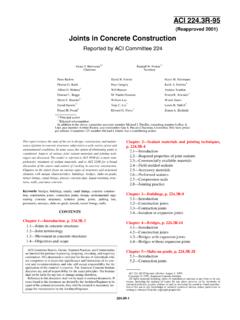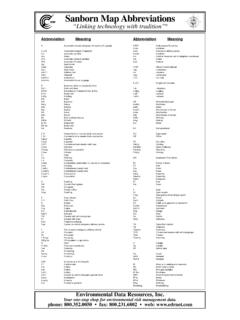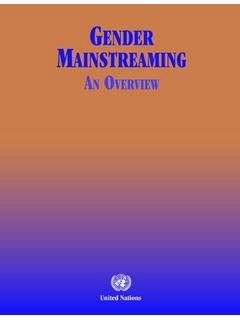Transcription of Standard Specification for Concrete Aggregates1
1 Designation: C 33 03 Standard Specification forConcrete Aggregates1 This Standard is issued under the fixed designation C 33; the number immediately following the designation indicates the year of originaladoption or, in the case of revision, the year of last revision. A number in parentheses indicates the year of last reapproval. A superscriptepsilon (e) indicates an editorial change since the last revision or Standard has been approved for use by agencies of the Department of Scope* This specification defines the requirements for gradingand quality of fine and coarse aggregate (other than lightweightor heavyweight aggregate)
2 For use in This specification is for use by a contractor, concretesupplier, or other purchaser as part of the purchase documentdescribing the material to be This specification is regarded as adequate to ensure satisfac-tory materials for most Concrete . It is recognized that, for certain work orin certain regions, it may be either more or less restrictive than needed. Forexample, where aesthetics are important, more restrictive limits may beconsidered regarding impurities that would stain the Concrete surface. Thespecifier should ascertain that aggregates specified are or can be madeavailable in the area of the work, with regard to grading, physical, orchemical properties, or combination This specification is also for use in project specificationsto define the quality of aggregate, the nominal maximum sizeof the aggregate.
3 And other specific grading responsible for selecting the proportions for the concretemixture shall have the responsibility of determining the pro-portions of fine and coarse aggregate and the addition ofblending aggregate sizes if required or The values stated in SI units are to be regarded as thestandard. The values given in parentheses are for The text of this Standard references notes and footnoteswhich provide explanatory material. These notes and footnotes(excluding those in tables and figures) shall not be consideredas requirements of this Referenced Standards:C 29/C 29 MTest Method for Bulk Density ( Unit Weight )and Voids in Aggregate3C40 Test Method for Organic Impurities in Fine Aggre-gates for Concrete3C87 Test Method for Effect of Organic Impurities in FineAggregate on Strength of Mortar3C88 Test Method for Soundness of Aggregates by Use ofSodium Sulfate or Magnesium Sulfate3C117 Test Method for Material Finer than 75- m (No.)
4 200)Sieve in Mineral Aggregates by Washing3C 123 Test Method for Lightweight Particles in Aggregate3C 125 Terminology Relating to Concrete and ConcreteAggregates3C 131 Test Method for Resistance to Degradation of Small-Size Coarse Aggregate by Abrasion and Impact in the LosAngeles Machine3C 136 Test Method for Sieve Analysis of Fine and CoarseAggregates3C 142 Test Method for Clay Lumps and Friable Particles inAggregates3C 150 Specification for Portland Cement4C 227 Test Method for Potential Alkali Reactivity ofCement-Aggregate Combinations (Mortar-Bar Method)3C 289 Test Method for Potential Alkali-Silica Reactivity ofAggregates (Chemical Method)
5 3C 294 Descriptive Nomenclature for Constituents of Con- crete Aggregates3C 295 Guide for Petrographic Examination of Aggregatesfor Concrete3C 311 Test Methods for Sampling and Testing Fly Ash orNatural Pozzolans for Use as a Mineral Admixture inPortland-Cement Concrete3C 330 Specification for Lightweight Aggregates for Struc-tural Concrete3C 331 Specification for Lightweight Aggregates for Con- crete Masonry Units3C 332 Specification for Lightweight Aggregates for Insulat-ing Concrete3C 342 Test Method for Potential Volume Change ofCement-Aggregate Combinations5C 441 Test Method for Effectiveness of Mineral Admixturesor Ground Blast-Furnace Slag in Preventing Excessive1 This specification is under the jurisdiction of ASTM Committee C09 onConcrete and Concrete Aggregates and is the direct responsibility of on Normal Weight edition approved June 10, 2003.
6 Published July 2003. Originallyapproved in 1921. Last previous edition approved in 2002 as C 33 lightweight aggregates, see SpecificationsC 331, C 332, and C 330; forheavyweight aggregates see SpecificationC 637and Descriptive NomenclatureC Book of ASTM Standards,Vol Book of ASTM Standards, Vol ; see2001 Annual Book of ASTM Standards, Vol *A Summary of Changes section appears at the end of this ASTM International, 100 Barr Harbor Drive, PO Box C700, West Conshohocken, PA 19428-2959, United of Concrete Due to the Alkali-Silica Reaction3C 535 Test Method for Resistance to Degradation of Large-Size Coarse Aggregate by Abrasion and Impact in the LosAngeles Machine3C 586 Test Method for Potential Alkali Reactivity of Car-bonate Rocks for Concrete Aggregates (Rock CylinderMethod)
7 3C 595 Specification for Blended Hydraulic Cements4C 618 Specification for Coal Fly Ash and Raw or CalcinedNatural Pozzolan for Use as a Mineral Admixture inConcrete3C 637 Specification for Aggregates for Radiation-ShieldingConcrete3C 638 Descriptive Nomenclature of Constituents of Aggre-gates for Radiation-Shielding Concrete3C 666 Test Method for Resistance of Concrete to RapidFreezing and Thawing3C 989 Specification for Ground Granulated Blast-FurnaceSlag for Use in Concrete and Mortars3C 1105 Test Method for Length Change of Concrete Due toAlkali-Carbonate Rock Reaction3C 1157 Performance Specification for Hydraulic Cement4C 1240 Specification for Use of Silica Fume as a MineralAdmixture in Hydraulic-Cement Concrete , Mortar, andGrout3C 1260 Test Method for Potential Alkali Reactivity ofAggregates (Mortar-Bar Method)
8 3C 1293 Test Method for Concrete Aggregates by Determi-nation of Length Change of Concrete Due to Alkali-SilicaReaction3D75 Practice for Sampling Aggregates6D 3665 Practice for Random Sampling of ConstructionMaterials6E11 Specification for Wire Cloth and Sieves for TestingPurposes73. For definitions of terms used in this Standard , refer toTerminologyC Ordering and Specifying The direct purchaser of aggregates shall include theinformation the purchase order as applicable. A projectspecifier shall include in the project documents information todescribe the aggregate to be used in the project from theapplicable items Include in the purchase order for aggregates the follow-ing information, as Reference to this specification, as C 33____, Whether the order is for fine aggregate or for coarseaggregate, Quantity, in metric tons or tons, When the order is for fine Whether the restriction on reactive materials , In the case of the sulfate soundness test ( )which salt is to be used.
9 If none is stated, either sodium sulfateor magnesium sulfate shall be used, The appropriate limit for material finer than 75- m(No. 200) sieve (seeTable 1). If not stated, the % limit shallapply, The appropriate limit for coal and lignite (seeTable1). If not stated, the % limit shall apply, When the order is for coarse The grading (size number) ( 2), oralternate grading as agreed between the purchaser and aggre-gate The class designation ( 3), Whether the restriction on reactive materials , In the case of the sulfate soundness test (seeTable3), which salt is to be used.
10 If none is stated, either sodiumsulfate or magnesium sufate shall be used, Any exceptions or additions to this specification (seeNote 1). Include in project specifications for aggregates thefollowing information, as Reference to this specification, as C When the aggregate being described is fine Whether the restriction on reactive materials , In the case of the sulfate soundness test ( )which salt is to be used. If none is stated, either sodium sulfateor magnesium sulfate shall be The appropriate limit for material finer than the75- m (No.)







![arXiv:2012.15671v4 [cs.CL] 16 Aug 2021](/cache/preview/2/b/c/f/0/7/1/e/thumb-2bcf071e7a756941cc4b2de078ca7d63.jpg)



